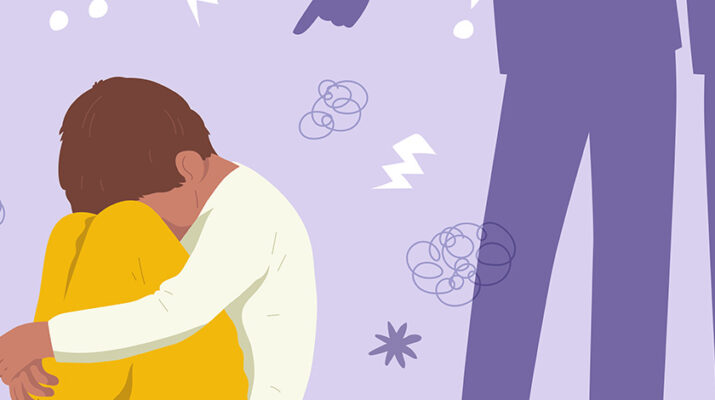By Deborah Jeanne Sergeant
In 2020, 618,000 children in unique incidents were victims of abuse and neglect, according to The National Children’s Alliance. Of these cases, 65% included sexual abuse, 20% physical abuse, 8% neglect, 8% witness to violence, 3% drug endangerment and 8% were other types of abuse or neglect.
Emotional abuse overlaps each of these categories, can occur in the absence of other kinds of abuse, and often goes unreported. These factors make it difficult to estimate how many children experience emotional abuse and child assault. But researchers estimate that at some point, about 40% of children suffer from it.
Emotionally abusive parents differ from those who exhibit an occasional moment of poor reaction and apologize afterwards.
“It is psychological violence,” said Grace Puchalski, licensed clinical social worker and owner of Walk with Grace in Liverpool, quoting from a recent definition from the American Psychiatric Association. “It is non-accidental, verbal or symbolic act by a child’s parent or caregiver that results in or have reasonable potential to result in significant psychological harm to the child.”
These acts may include manipulation, maligning, belittling accomplishments, gaslighting, taunting and degrading. It is earmarked by yelling, screaming, name calling, cursing and swearing and put-downs.
“People underestimate the damage because people can’t see it like physical abuse,” Puchalski said. “It injures the child’s self-esteem and wellbeing.”
These can include health problems, difficulty in reaching age-appropriate developmental milestones, relationship problems and socioeconomic challenges, to name a few.
Puchalski said that some children may bully others.
As adults, “they would be prey to other people who target those who are vulnerable,” she added. “They have trouble with relationships at work and romantic relationships. They may experience substance abuse, criminal behavior and as the most extreme examples, homicide or suicide.”
Parents who habitually engage in abusive behaviors teach their children that relationships are dangerous and result in confusion and emotional pain.
Other trusted adults may inflict emotional abuse. However, the closer the person is to the children, the more damage the abuse inflicts. In the case of an adult outside the family, the children’s resiliency factors can make a difference as to how much damage the emotional abuse causes.
For example, parents who stick up for their children and support them in a conflict with caustic teacher can help their children learn how to deal with treacherous people and reinforce their own caring relationships.
Helping children find ways to express their thoughts and feelings without judgment is one way that parents can help children feel supported when an emotional trauma occurs.
“Children need safe, stable environments to help them mitigate these effects,” said Laura Maggiulli, director of research at Hillside in Rochester. “A youth without those factors —that’s where more often we’ll see lasting impacts of trauma. They don’t have the supports to help them process the trauma.”
Lacking this environment can result in what, Maggiulli calls “toxic stress,” when the brain becomes so conditioned to respond to stress and danger that it becomes stuck in the fight or flight mode for long periods.
“This leads to disruption in development,” she said. “This endures into long-term consequences that basically follow you into adulthood. These lasting impacts can be linked to things like health problems. Some of the biggest are cancer, diabetes, asthma and kidney disease. They can oftentimes be linked back to mental illness and risky behavior like substance abuse. They have a higher risk of unemployment.”
For some families, emotional abuse becomes a multi-generational issue as the following generations mimic the behavior they saw in their parents as children. From childhood, their brains have been hardwired to automatically resort to fight or flight mode in the face of conflict instead of extending compassion and understanding. Their understanding of relationships has been skewed into one of competition instead of cooperation.
Breaking the cycle of childhood emotional abuse relies upon the adults addressing their own issues first before changing how they relate and behave with their children.
“Being able to recognize and become aware of the deficiencies is important,” said Samantha G. Stringer, licensed mental health counselor in private practice in Rochester. “At some point in life, we do see our deficits, whether it’s by someone sharing what they see in us or by the emotional hole that’s evident. I believe that everyone has it in us to get to that point where we realize something’s going on. Something doesn’t seem right; I need some help.”
She has treated clients who as young adults do not understand why they act the way they do, but once they begin talking about their childhood, a pattern of abuse emerges: yelling, cursing, emotional or physical abuse.
At that point, they begin to better understand that this behavior is unwarranted and they can work towards changing themselves because they do not want to follow that pattern.
Stringer recommends psychotherapy and talk therapy for unpacking and healing childhood trauma, whether as a child or adult.
“They can do better, think better, live better, have better physical and mental health,” Stringer said. “There is a slew of things we can do. I think about the spiritual aspect of it as well, knowing that spiritual side of yourself and looking at life for what it is.”
She also emphasizes developing purpose and engaging in regular self-care.
“We’re often compassionate with our feelings to friends and family and having that same self-compassion can go a long way,” Stringer added.

